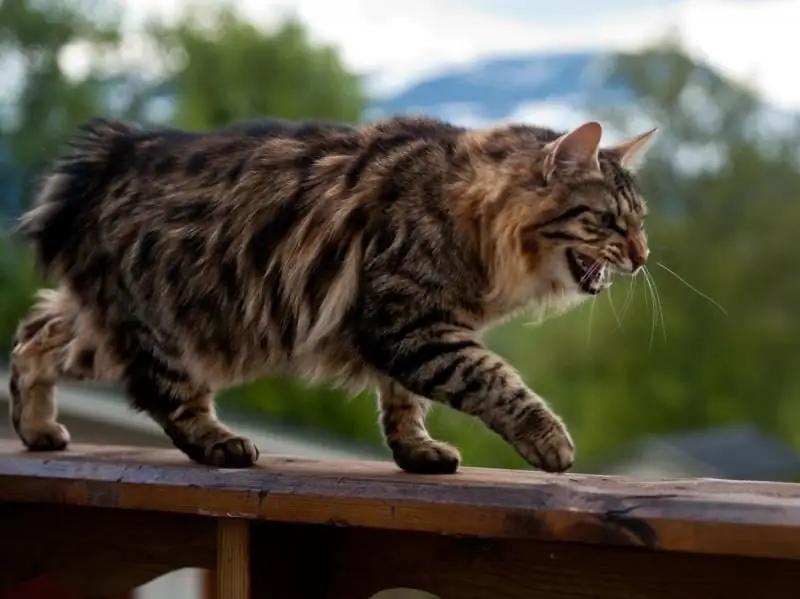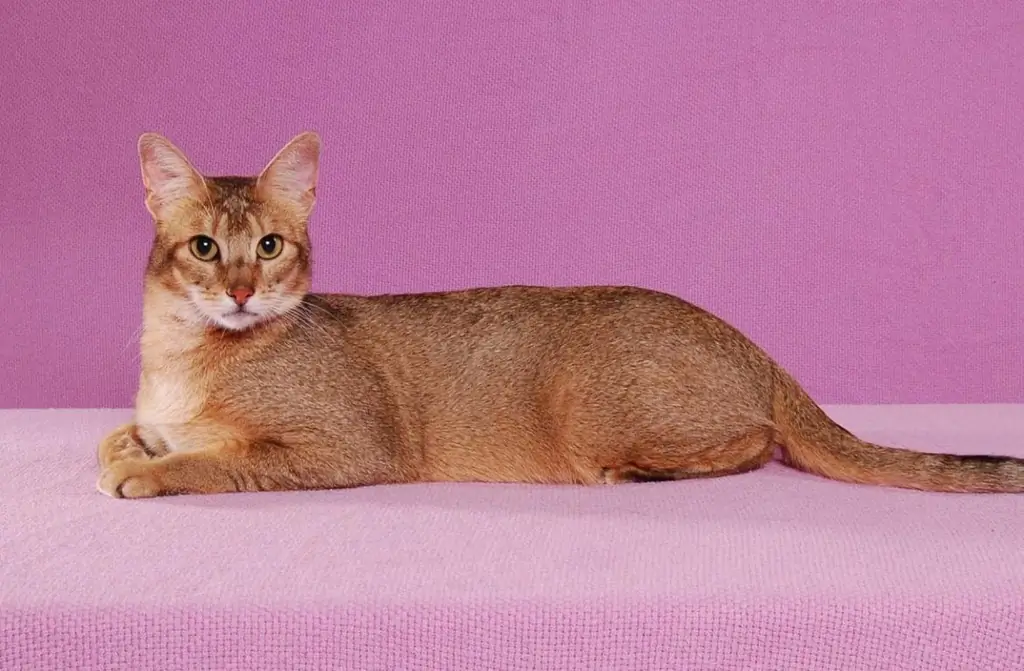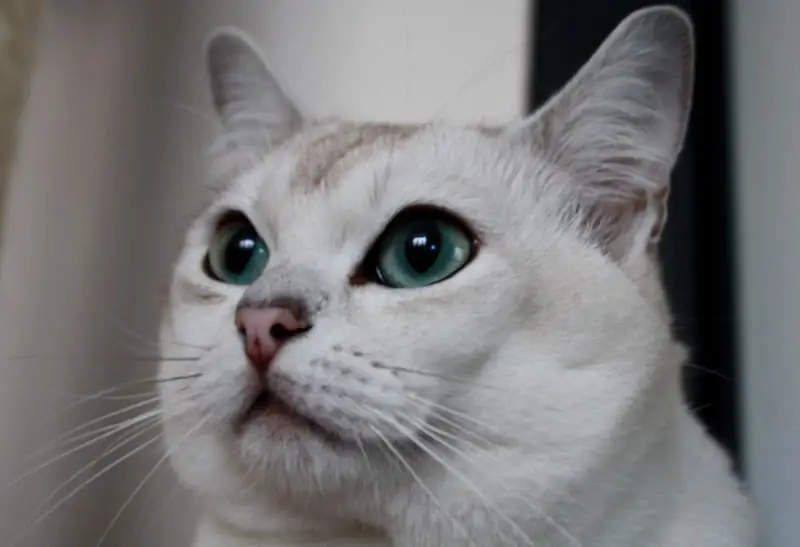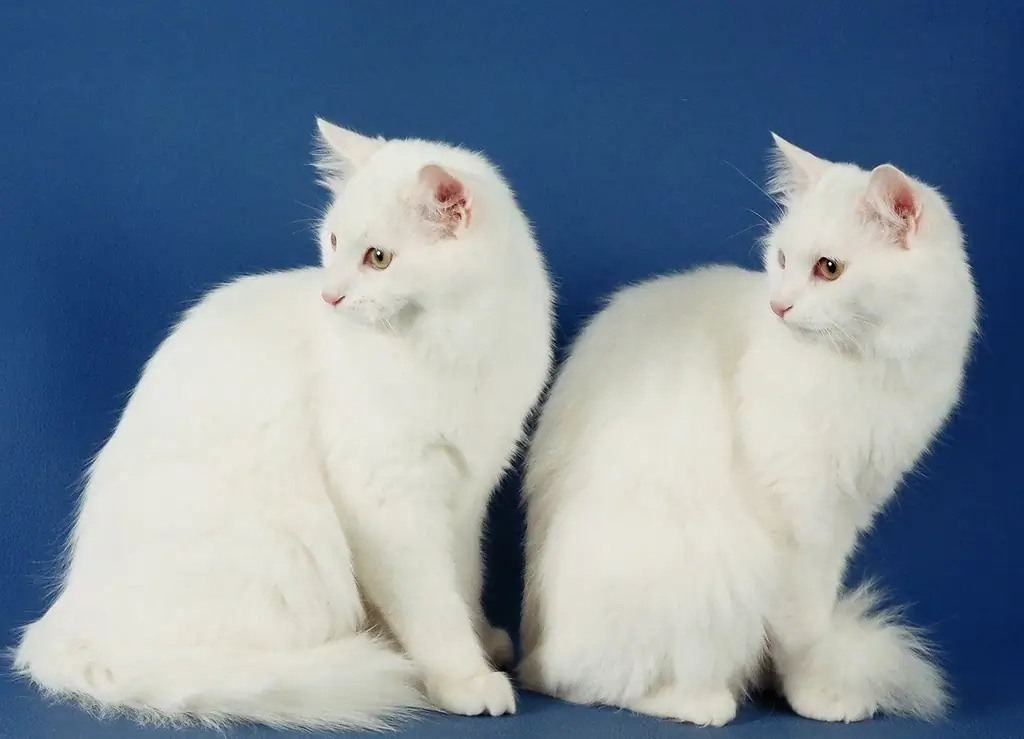
Table of contents:
- Author Bailey Albertson [email protected].
- Public 2024-01-17 22:26.
- Last modified 2025-01-23 12:41.
Peterbalds: mysterious cats

Peterbald is one of the brightest and most unusual breeds of domestic selection cats. These hairless pets are smart, graceful, intelligent, they adore their owners and create a unique atmosphere of love, care and comfort in the house.
Content
-
1 Peterbald - breed from the banks of the Neva
- 1.1 Photo gallery: breeds whose blood was used to create the Peterbald
- 1.2 Video: Peterbald - history and reality
-
2 Features of the St. Petersburg Sphinx
-
2.1 External data
2.1.1 Photo gallery: peterbald color palette
- 2.2 Types of peterbald
- 2.3 Character and behavior
-
2.4 Disadvantages of the breed
2.4.1 Disease Propensity
-
-
3 Choosing a Peterbald kitten
- 3.1 With or without wool
-
3.2 Criteria and guarantees
3.2.1 Video: Peterbald kittens explore the territory
-
4 How to care for a Peterbald
- 4.1 Hygiene
- 4.2 Feeding
-
4.3 Exercise and temperature conditions
4.3.1 Video: how and where to keep the Peterbald
- 4.4 Toilet
-
5 Breeding work
-
5.1 Features of breed breeding
- 5.1.1 From mating to childbirth
- 5.1.2 Peterbald kittens
- 5.2 Sterilization issues
-
- 6 Owner reviews
Peterbald - breed from the banks of the Neva
Peterbald is the second name of the St. Petersburg Sphinx, and “cat lovers” affectionately call their favorites petriks. This wonderful breed appeared in St. Petersburg as a result of crossing the Oriental Shorthair cat and the Don Sphynx.

Petersburg felinologists have created a real cat masterpiece
The bold idea of creating an exclusive cat was realized in 1994, when the first experimental mating of the Don Sphynx Afinogen Myth and the oriental cat Radma von Jagerhof was carried out. As the founders of the new breed expected, most of the babies in the litter were similar in type to the Oriental, but differed from them in almost complete absence of hair. Four kittens from the first two litters were selected for further selection.
Already in 1996, the exclusive hybrid breed received its first official recognition. Today these unusual cats are in demand all over the world, and their popularity is growing quite rapidly.
Photo gallery: breeds whose blood was used to create the Peterbald
-

Oriental cat - The St. Petersburg Sphynx received ideal body proportions from orientals
-

Siamese cat - Siamese cat gave Peterbald a palette of point colors and big ears
-

Don Sphynx - The hairless gene passed to a new breed from the Don Sphynxes
-

Balinese cat -
Petersbolds have a little Balinese blood, they provide grace and plasticity
Video: peterbald - history and reality
Features of the St. Petersburg Sphinx
Regal posture, aristocratic manners, amazing grace of lines and movements - Peterbald is harmonious in everything, to the smallest detail. High intelligence and wonderful character should be added to the bouquet of his merits.

Petersburg Sphinx - sculptural perfection
External data
Breed standards prescribe the same stats for Peterbald cats as for oriental or Siamese cats:
- medium size - a cat weighs about five kilograms, and a cat - up to four;
- slender body;
- Long neck;
- the trunk tapers from the chest to the hips;
- skin fold along the abdomen;
- high slender legs - the hind legs are slightly longer than the front ones;
- the tail is very long and thin.
Compared to the body of the cat, its head seems small, but it fits very harmoniously into the overall image. The wedge-shaped "face" is crowned with large ears. The profile of the cat is characterized by a smooth transition from a sloping forehead to a long nose.

The mustache of "bald people" twists, breaks, or even absent altogether
By the way, the Peterbald is significantly different from its progenitor - the stocky and well-knocked Don Sphinx. The Petersburger is surprisingly elegant and exquisitely refined. Such grace was given to the new breed by its other ancestors - Oriental and Siamese. From them, the new breed received the shape of the head, its wonderful ears and a wide variety of colors.
Almost all colors are recognized, although some breeders find it undesirable to have shades of chocolate in any of its variations . Only the Siamese color is known for up to fifty different variants. The following breed colors are considered traditional:
- the black;
- white;
- red;
- blue;
- tortoiseshell.

In one litter, kittens that are completely different in color and the presence of hair may appear
Photo gallery: peterbald color palette
-

Peterbald peach - Peach color - beautiful, rare, but problematic
-

Peterbald bicolor - Peterbalds have a huge variety of bicolor options
-

Peterbald blue - Beautiful blue peterbald dogs can have bad heredity
-

Peterbald cream - The cream color of the St. Petersburg sphinxes is becoming very fashionable
-

Peterbald black - And yet a black cat is the height of perfection, even if it is without hair
-

Peterbald tortoiseshell - The tortoise color was in the ancestor of the Peterbalds, an oriental cat
-

Peterbald white - Petersburg Sphynx white color - the personification of tenderness
Types of peterbald
Like the Don Sphynxes, Peterbalds can be completely bald and not very. There are several varieties of wool cover in the breed:
- gammi, or "rubber" cats, - the hair is completely absent;
- flock - the length of the fur does not exceed two millimeters, there are usually no eyebrows and mustaches;
-
velor - soft and longer than flock, wool;

Peterbald with wool The wool of velor peterbald is very soft and pleasant to the touch
- brush, from the English word "brush" ("brush") - rather hard and rare twisted hairs can grow up to almost a centimeter;
- brush point - there is more wool on points (paws, tail and muzzle) than on brushes, and the body is covered with flock "dust";
- straight-haired - practically do not differ from orientals.
Character and behavior
Peterbald is very active, mobile and jumpy - he will effortlessly fly up to a tall cabinet, and literally a second later he will be on the windowsill in the far corner of the room. However, these cats move absolutely without destruction, gracefully and accurately. Torn curtains or scratched upholstered furniture are definitely not about them.
Good character is an undoubted merit of the St. Petersburg Sphinxes. These cats are affectionate, peaceful and unforgettable. They do not tolerate loneliness and are happy to communicate with people. They roam everywhere behind the owner with a tail and at any convenient moment they climb into his arms, from where it is not so easy to drive them away.

Peterbald's favorite place is in the hands of the hostess
They are especially famous for their talent to find a common language with dogs, on which they themselves are similar in character. Peterbalds are smart and highly trainable - if desired, they can be taught several commands. And to bring a small object thrown by the owner is one of the favorite entertainments of this cat.
Most of their character traits were inherited from the oriental cat, including increased talkativeness. They love to sing songs, talk and express their own opinion on any occasion. So if you want peace and loneliness, a sociable Peterbald is definitely not for you.
They are inquisitive, adaptive and easy-going - and a short walk in unfamiliar places, or even a long journey, is no problem for them.
Disadvantages of the breed
Anyone who is fortunate enough to become the owner of a Peterbald will hardly ever be able to exchange his affectionate pet for a representative of any other breed of cats. But the Peterbald people have their drawbacks.
Disease propensity
For the most part, St. Petersburg Sphynxes are healthy animals with a strong immune system. With timely vaccination and proper maintenance, they do not get sick with anything serious and live for a long time, at least twelve years.
The most vulnerable spheres of the Peterbald are its skin and mucous membranes. Most often, skin problems arise in "rubber bands" - hairless representatives of the breed. Such animals are often prone to allergies, especially during puberty. At the same time, acne often appears on the bare tails of teenage cats - the same as in human teenage cubs. Acne needs to be treated - or castrated to balance hormones.

The skin of peterbolds is prone to various rashes, more often of an allergic nature
Also St. Petersburg sphinxes are prone to colds. Cold, dampness and drafts are their worst enemies. Remember this when equipping a sleeping place for your pet, and even more so - a nest in which a young mother will raise her kittens.
Choosing a Peterbald kitten
Exotic appearance and cute intelligent disposition are not the only advantages of the St. Petersburg Sphinx. This is one of the rare cat breeds that is suitable for people suffering from allergies, in addition, the Peterbald has absolutely no unpleasant odor, even during active mating periods.
Small Peterbalds are born with varying degrees of overgrowth, and it is absolutely not a fact that the same type of wool will remain in animals in adulthood. Even experienced breeders may not always be able to give an accurate prediction of whether a particular cat will “undress” as it grows and to what extent.

No one will say for sure what these littermates will become when they grow up.
With or without wool
Observations show that in a standard litter of five kittens, one is flock, two are brushed, and two more are gamma, that is, absolutely naked. Although here, of course, options are possible. The animal's coat is fully formed only by two years. So buying a baby Peterbald is always a lottery.

"Rubber" kids are the most desirable, but also the most problematic
Criteria and guarantees
If you have already decided on the exact image of the cat of your dreams, go to the breeding cattery for her - only there you can get St. Petersburg Sphynxes. The authority, honest name and experience of the breeder will guarantee that you are really buying a purebred animal, and not a bald mestizo of unknown origin. An even more important factor is the genetic health and good rearing of the baby - a lot of attention is paid to this in the nursery.
Since responsible breeders sell young animals no earlier than four months after full vaccination, the main characteristics of the animal can already be considered and evaluated.

As kittens grow up, their breed qualities become more noticeable.
For a thoroughbred, although still small, Peterbald, the correct shape of the head is very important - it should be elongated, wedge-shaped, with large, low-set ears and huge slanted eyes. The elongated graceful body with a thin whip-like tail is in many ways reminiscent of the proportions of oriental cats, but differs from them in the direction of sophistication and aristocracy.
Video: Peterbald kittens explore the territory
How to care for a Peterbald
It is generally accepted that the St. Petersburg Sphynx is a cat only for experienced owners, and this is true. There are many nuances of caring for these animals, which must be known and followed. However, caring for a Peterbald is not difficult, with certain skills even a beginner can cope with it. Moreover, smart and docile pets know well: the regular procedures that the owner does with them will be beneficial, and they always endure them with great patience.

Peterbald takes good care of himself, but he needs help
Hygiene
Most of the questions are raised by the bathing of the Peterbald. Especially with regard to gammi - hairless representatives of the breed. The fact is that the skin of "rubber bands" in large quantities releases a protective lubricant (wax-like brownish coating), which successfully protects the body from many negative factors. Constantly washing off this lubricant means leaving the skin defenseless, and at the same time upsetting its balance. It is unreasonable, especially since bald people already have a lot of dermatological troubles. It turns out that you don't need to bathe them.
On the other hand, dust and all sorts of small debris that any cat manages to find even in a perfectly clean room sticks to this very lubricant. There is nothing good about that either. Approach the solution to the problem individually, based on the characteristics of a particular cat.

Peterbald takes warm baths with delight
Someone simply wipes their beloved bald person with a damp soft cloth or a terry towel - cheap, angry and safe. Others thoughtfully choose a mild detergent for their pet - fortunately, their range is very large. Most owners simply rinse their cat with warm water in the bath from time to time - by the way, many gammas are very fond of swimming and are not at all afraid of water, they even turn bathing into a fun game.
With all other non-bald varieties of the breed, the question is not so acute - cats are bathed as often as necessary - about once every two months.

Bathing Peterbalds with special shampoos for hairless cats
For those who have at least some vegetation on their bodies, combing is also not an idle question. Of course, a slicker and fumigator, useful for other breeds, are unlikely to be useful in your case. A soft rubber brush or silicone glove will do just fine. Regular unobtrusive massage peterbald take with pleasure.

A hairbrush is only needed at an exhibition, but in ordinary life, a massage brush or mitten is enough
The ears and eyes of Peterbald people are practically not protected by wool, so more dust gets into them, and systematic cleaning is extremely necessary for them. If the problem is not too neglected, then a cotton pad and ordinary boiled water are enough for cleaning procedures; you can also use a special lotion. If the discharge is profuse and has an unpleasant odor, it is necessary to immediately consult a doctor.
But with a haircut of the claws as they grow back, you can do a great job yourself. All you need is a good nail clipper and at least one assistant.
The St. Petersburg Sphynx has a strong dental system, but nevertheless, the teeth must be cleaned of plaque at least twice a month using a special cat brush and paste. If such a simple procedure does not help, then you should not wait for the formation of tartar - it is better to show the animal to the veterinarian, who at the same time will determine whether the hygienic problem is medical: it is possible that there are disturbances in the functioning of the digestive system, or maybe your cat does not fit what you feed her.
Feeding
Food allergy is a common problem for all varieties of St. Petersburg Sphynxes. Very often, their body does not accept chicken meat, and sometimes other natural products. Therefore, ready-made hypoallergenic feed is still the most reliable type of nutrition. It is definitely not worth saving on them - your regal cat should receive only a super premium class diet.
Metabolism in these cats is very fast. In order to keep warm in the absence of wool, they have to maintain a high body temperature, and even a lot of energy is spent on active behavior. To be always in good shape, the pet seeks a lot and often to refresh itself - and sometimes does not know the measure.
Feed your pet not in large portions, but fractionally, and more often - this will help him not to dwell on the feeling of hunger. Moreover, overeating for this breed is extremely undesirable.

Tears from the Peterbald's eyes are a mechanism for washing them, and not a manifestation of feelings
Exercise and temperature regime
Peterbalds - and not only naked - love warmth very much. They will definitely need warm clothes, cozy houses and couches, preferably heated for the cold season. Many owners try to place their pets closer to radiators or other heating devices. But this must be done with great care, since burns can easily occur on the delicate skin of these cats.

You should always take care to keep your pet warm.
A wardrobe should be selected not according to the degree of fashion and prestige, but according to how comfortable and safe the clothes are. Clothes should be made of soft fabrics and always with seams outward, so as not to form abrasions, which will not be easy to treat.
The optimum air temperature in the apartment is 20-25 degrees. Despite the heat-loving nature of the Peterbalds, overheating will also not benefit them. Another danger lies in the passion of this breed for sunbathing. They love to sunbathe, but getting carried away can get sunburn. Then the skin becomes inflamed and reddened and then takes on an unwanted brownish tint.

Windows, in which Peterbald likes to look out, will have to be shaded in the summer
Video: how and where to keep peterbald
Restroom
Buying a little Peterbald in the nursery, you get a pet that is already perfectly accustomed to using the toilet. So that there are no problems at the new place of residence, create the conditions familiar to the kitten. Ask the breeder what tray and type of litter was used in the nursery - and offer the same to your baby.
Tribal work
Unfortunately, there is still no general program for the development of the breed - despite the clear positions of the standard, the breeders did not come to a consensus, and they have their own reasons for that. But in general, the breed is actively developing towards a variety of colors and extreme types of animals. For this purpose and for the expansion of the gene pool of Peterbalds in breeding work, until recently, the blood of oriental cats was used: Siamese, Oriental, Balinez. Now the breed is already closed and mating is allowed only inside it.
Features of breed breeding
Due to the high percentage of eastern bloods, Peterbalds are usually prolific. This contributes to breeding work and allows you to quickly navigate what qualities this or that parental pair can transmit to offspring.
From mating to childbirth
The parental pair is selected not so much according to the degree of "undressing" of the producers, but according to the successful combination of their genotypes and phenotypes. It is very important that the breeder planning to mate is aware of the hereditary health of several generations of cats behind the future parents, and also does not allow animals with obvious anatomical defects in breeding.
For breeding work, animals are selected that have already fully formed physically - not earlier than two years of age. The bride and groom must be absolutely healthy, vaccinated in a timely manner and treated against all types of parasites. Mating traditionally takes place in the cat's territory, where he feels much more confident, and is repeated twice or three times with an interval of one day.

The "newlyweds" usually have very touching relationships.
The expectant mother usually bears and gives birth to heirs without any problems, but during pregnancy she requires increased attention to herself: more, affection, tenderness, care and respect - do not forget about this, for a Peterbald such a person's attitude is especially important.
Peterbald kittens
The maternal instinct of the Peterbalds is excellently developed - a kitten of this breed is ready to feed not only her own, but also other people's kittens. They constantly lick the cubs and generally pay them a lot of attention, patiently educating the younger generation for a long time.

Peterbald cats are caring and attentive mothers
Breeders are well aware of a curious pattern: the less wool a newborn Peterbald has, the earlier it will open its eyes. Absolutely "rubber" babies are usually born with open eyes, and you need to be vigilant to protect them from infections so that conjunctivitis does not develop. Such a breed type in the first weeks of life is difficult to develop, the mortality rate in hairless kittens is quite high. However, by the age of one and a half months, all health problems usually remain in the past.

Kittens with soft coats are more likely to become completely hairless by adulthood.
Flat-haired kittens and hard-brushed kittens usually do not undress by adulthood. Only those individuals in which it is soft from birth are shed.
Sterilization issues
If you have a St. Petersburg Sphynx, but do not plan to seriously engage in breeding work, then it is definitely better to sterilize the animal in a timely manner. The hormonal balance in Peterbald people is rather unstable, and the lack of demand for animals in breeding is fraught with serious diseases.
In addition, sterilization can become a sine qua non for the sale of a pet-class kitten that is not promising for breeding, and this is a fair requirement. Sterilization or castration is optimal for Peterbald people aged from one to one and a half. The operation can only be trusted by experienced specialists in a veterinary clinic; a responsible recovery period should also take place under their control.
Video:
Owner reviews
A young but bright breed of St. Petersburg Sphynx is in demand all over the world and has excellent prospects. The number of Peterbald fans is constantly growing, this wonderful cat deserves great popularity and world fame.
Recommended:
Kurilian Bobtail: Photo, Description Of The Breed, Character And Behavior Of The Cat, Reviews Of The Owners Of The Cat, The Choice Of A Kitten

The history of the Kurilian bobtail. Description of the breed. The nature and behavior of Kuril cats. Diseases of the breed. Buying a kitten breed. Care and hygiene. Breeding. Reviews
Persian Cat: Photo, Description Of The Breed, Character And Content Of The Persian, How To Choose A Kitten With A Flattened Muzzle

Description of the breed. Varieties of the Persian cat. Features of the appearance, character and care of the cat. How to choose a kitten. Possible diseases. Host Reviews
Chausie: Description Of The Breed, Character And Habits Of A Houseie Cat, Photo, Choice Of A Kitten, Reviews Of Cat Owners

The history of the origin of Chausie. Breed standard. Character, behavior, health. Features of nutrition. Tips for choosing a Chausie kitten. How to breed. Reviews. Video
Cat Burmilla: Description Of The Breed, Nature And Features Of The Content, Photos, Choosing A Kitten, Reviews Of The Owners, Breeding Cats

The origin of the Burmilla breed. Features of appearance and behavior. Acquisition and breeding issues. Care and hygiene of the Burmilla. Life expectancy. Reviews
Angora Cat: History Of The Breed's Origin, Appearance And Photos, Features Of Character And Care Of The Cat, Reviews Of The Owners

History of the Angora breed. Features of appearance and character. Disadvantages of the breed. Proper care and feeding. How to choose a kitten. Breeding the breed. Reviews
